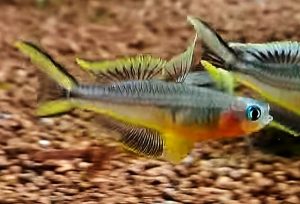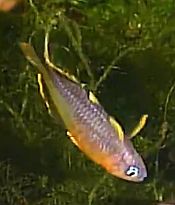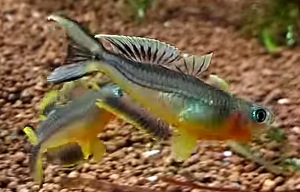The Forktail Rainbowfish (Pseudomugil furcatus) also know to tropical fish keeping enthusiasts as the Yellow Rainbow, is a peaceful, shoaling species that is found in a relatively small area in eastern Paupua New Guinea. Specimens were first collected from Peria Creek, Kwagira River and subsequently recorded in the Musa and Kwagila river basins, which both drain into Dyke Ackland and Collingwood Bay.
Forktail Rainbowfish are found in the clear, slow to moderately moving, heavily vegetated forest streams of their range where they opportunistically feed on zooplankton, phytoplankton, and invertebrates.
Forktail Rainbows are hardy, active, darting swimmers, with sleek oblong bodies that in an aquarium environment should be kept with at least 10 or more of their own kind.
Pseudomugil furcatus are a beautiful little species that max out at a little over 2 inches in length. These little gems have blue eyes with bright, lemon yellow edged dorsal, pelvic, and caudal fins, and darker yellow edged anal fins. They have two upturned, wing like pectoral fins that are also bright lemon yellow in color.
Their body color is predominantly silvery gray in color with an orange/yellow throat. During breeding season, the males are more highly patterned and will develop vibrant yellow, orange, red, blue and green shades with stripes or bars. The unpaired upturned fins in the males become noticeably extended as they mature.
Females and juveniles are identically colored, but are more drab in appearance.
Forktail Rainbowfish are best housed in a long, densely planted, biologically mature aquarium of at least 30 gallon capacity, with a dark, fine gravel or sandy substrate, some river rocks, driftwood roots, and floating plants
to diffuse overhead lighting. They require well oxygenated water with at least minimal water movement. A good filtration system with a small power head is highly recommended to replicate these conditions.
Pseudomugil furcatus can be housed in a biotope environment however, they make a perfect addition to a peaceful community tank and can be housed with similar species such as tetras, danios, rasboras, other dwarf Rainbows, dwarf cichlids, or the Peacock Gudgeon (Tateurndina ocellicauda) which it occurs with in nature, etc.
Apparently all Pseudomugil furcatus bred on a commercial basis originated from a single collection obtained in 1981. They are easy to breed in an aquarium environment but because of years of
inbreeding, have a low hatch out rate and a high rate of deformity in the fry.
Forktail Rainbowfish are most likely to spawn in temperatures around 83°F. Spawning generally occurs during the daylight hours with the male mating with multiple females. The females will deposit a few relatively large eggs on aquatic vegetation or any suitable substrate, daily for a period of several days.
The simplest way to breed Forktail Rainbowfish is to keep a school of adults in a mature, densely planted aquarium with long rooted floating plants like Water Hyacinth. The fish will mate naturally and the fry will have a ready supply of food available when they hatch out.
An alternative method is to keep a group of 6 to 8 adults that are at least 8 months old in a breeding tank with an air powered sponge corner filter and some Java Moss, or a spawning mop. Feed the adults live foods until mating occurs and check they moss or mop for eggs daily. Separate the eggs from the adults as soon as they are detected into a mature brooding tank for incubation.
Depending on water temperature, the eggs generally hatch out in 21 days. Unfortunately, because of years of inbreeding, expect that over half of the eggs will be under sized, fail to develop, or be infertile.
The fry are able to eat microworms, baby brine shrimp
, or good quality finely ground flake or fry food immediately upon hatching. Feed the fry small portions at least twice a day and remove any accumulated uneaten food from the tank as soon as possible. Partial water changes with aged aquarium water are also recommended.
Apparently breeders are able to get eggs with developed embryos that have not hatched out to hatch, by placing them in a pill container with some aquarium water and occasionally shaking it until the embryos hatch out. The pressure change caused by shaking the pill container causes the eggs to hatch out. Neat trick.
In it’s natural environment, the Forktail Rainbowfish is an omnivore that feeds on phytoplankton, zooplankton, invertebrates, etc. on the surface or suspended in the water column. In an aquarium environment, they will eagerly accept a good quality crushed flake food but they do best on a diet of live foods such as Moina
, Daphnia
, brine shrimp
, microworms
, etc.
Forktail Rainbowfish (Pseudomugil furcatus) are available online and from specialty tropical fish keeping shops at reasonable prices. Because they are red listed as a threatened species, no wild specimens are available to the aquarium trade. All specimens are commercially bred.
Minimum Tank Size: 30 gallons
Care Level: Relatively easy
Temperament: Peaceful
Water Conditions: 75.2 – 83.3 °F, pH 7.0 – 8.0, H 268-536 ppm.
Max. Size: 2.4″
Color Form: Yellow, Grey
Diet: Omnivore
Compatibility: Excellent Community Tank
Origin: New Guinea
Family: Pseudomugilidae
Life Span: 3 years
Aquarist Level: Intermediate





